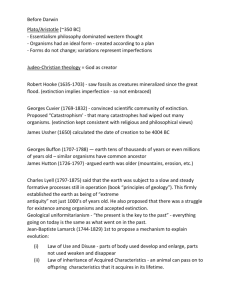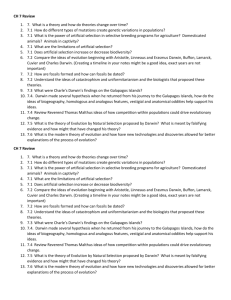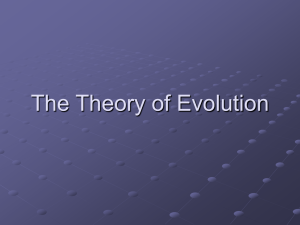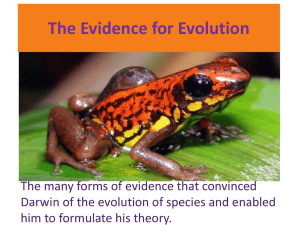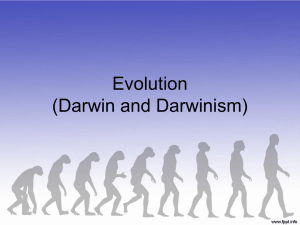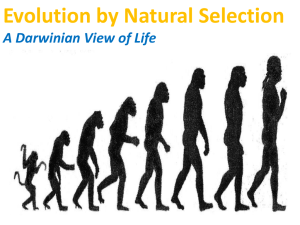Evolution 15 Define the following terms: analogous structure
advertisement
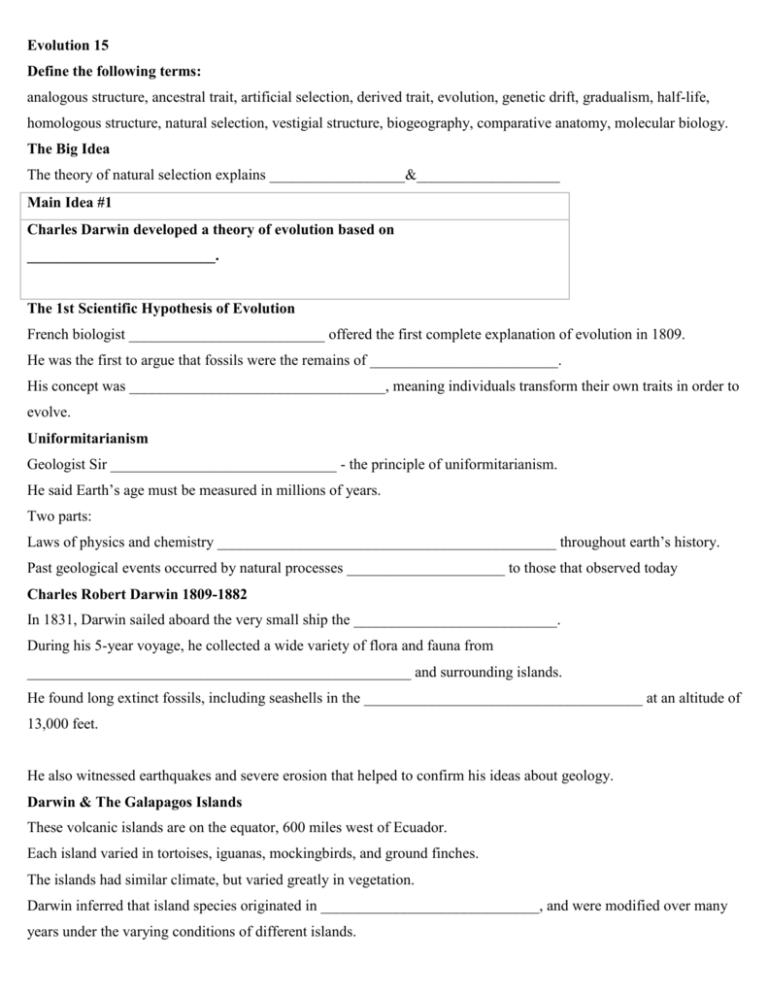
Evolution 15 Define the following terms: analogous structure, ancestral trait, artificial selection, derived trait, evolution, genetic drift, gradualism, half-life, homologous structure, natural selection, vestigial structure, biogeography, comparative anatomy, molecular biology. The Big Idea The theory of natural selection explains __________________&___________________ Main Idea #1 Charles Darwin developed a theory of evolution based on _________________________. The 1st Scientific Hypothesis of Evolution French biologist __________________________ offered the first complete explanation of evolution in 1809. He was the first to argue that fossils were the remains of _________________________. His concept was __________________________________, meaning individuals transform their own traits in order to evolve. Uniformitarianism Geologist Sir ______________________________ - the principle of uniformitarianism. He said Earth’s age must be measured in millions of years. Two parts: Laws of physics and chemistry _____________________________________________ throughout earth’s history. Past geological events occurred by natural processes _____________________ to those that observed today Charles Robert Darwin 1809-1882 In 1831, Darwin sailed aboard the very small ship the ___________________________. During his 5-year voyage, he collected a wide variety of flora and fauna from ___________________________________________________ and surrounding islands. He found long extinct fossils, including seashells in the _____________________________________ at an altitude of 13,000 feet. He also witnessed earthquakes and severe erosion that helped to confirm his ideas about geology. Darwin & The Galapagos Islands These volcanic islands are on the equator, 600 miles west of Ecuador. Each island varied in tortoises, iguanas, mockingbirds, and ground finches. The islands had similar climate, but varied greatly in vegetation. Darwin inferred that island species originated in _____________________________, and were modified over many years under the varying conditions of different islands. Darwin (continued...) Darwin conducted the remainder of his work at home in _________________________, where all of his notebooks had been sent home ahead of him in October 1836. His travel journal, _______________________________________, was published three years later, but he continued his research on the evolution of species by natural selection. Darwin first presented his ideas in a paper in 1844, but did not began writing the larger volume until 1856. By 1858, he had received a manuscript from ____________________________________ summarizing his ideas on natural selection. Geologist Lyell was instrumental in convincing Darwin to publish a joint paper with Wallace. Darwin’s book __________________________________________________________ was published in 1859. All printed copies sold out in one day. Darwin’s Theory of Evolution Darwin’s work actually included 5 separate theories. _______________________________________is the basic theory of evolution on which the others are based stating that the world is constantly changing. _______________________________________ (controversial theory) states that all forms of life descended from a common ancestor. _________________________________________________ - species divide and split into different species, which can no longer interbreed _____________________________ - large differences actually originate from an accumulation of many smaller differences Natural Selection ______________________________________________________________________________________________ ________________________________________________ Natural Selection & Speciation Natural Selection • The Ideas Behind Natural Selection: - Individuals in a population show ______________________. - _________________________________ can be inherited. - ___________________________ have more offspring than can survive on available resources. - Variations that increase ________________________________________ will have a greater chance of being passed on. Types of Evidence of Evolution 1. Fossil Record 2. Comparative Anatomy ___________________________- similar structures inherited from a common ancestor ____________________________ - structures that are reduced forms of functional structures in other organisms; get smaller over generations _____________________________ - structures that have similar function, but not similar shapes; not inherited from a common ancestor Evidence (continued...) ____________________________________ - many embryos share characteristics that are not alike in the adult form _____________________________________- the more closely related two species are, the more amino acid sequences they will share ______________________________________- evolution may be closely linked to climate and geographical characteristics Speciation Speciation is the evolutionary process by which _____________________________________________________________. ________________________________________- a physical barrier divides one population into one or more populations • mountain ranges, lava flows, channels between islands, wide rivers • believed to be the most common type of speciation ________________________________________ - no physical barrier separates the populations - the ancestor species and new species live side by side Types of Evolution ________________________________ - formation of organic molecules from inorganic substances _____________________________________- chemicals in the early ocean giving rise to organic, and eventually, living matter _______________________________________ - changing of a species into something different by the accumulation of small changes over time



